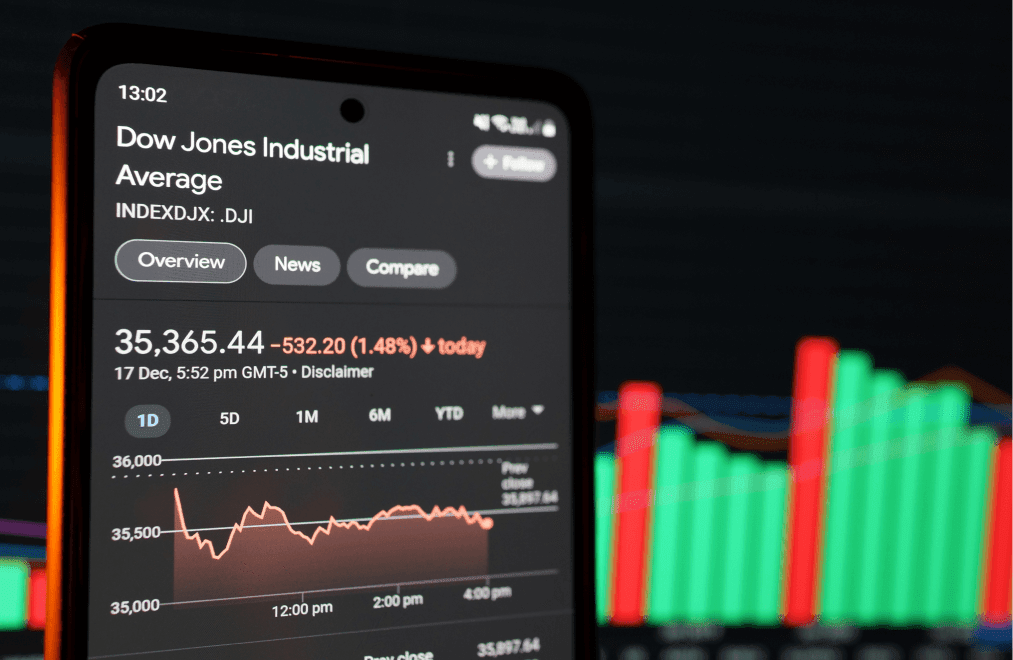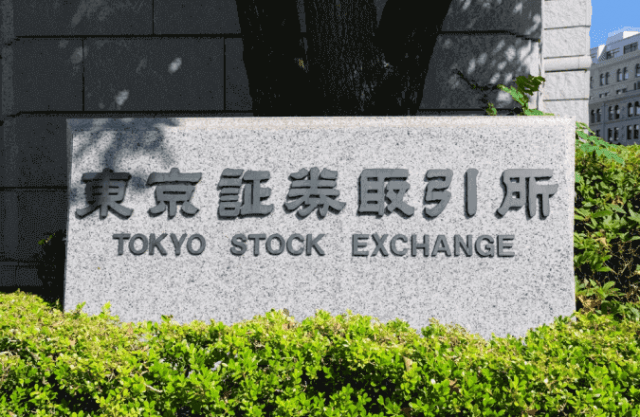A complete guide to the Dow Jones Index

Learn all about the Dow Jones stock index, with information on the Dow Jones companies and the Dow Jones live chart for price updates.
Go to market page
What is the Dow Jones?
The Dow Jones Index, or Dow Jones Industrial Average (DJIA), traded as the US Wall Street 30 on Capital.com, and often referred to simply as ‘the Dow’, is one of the oldest and most well-known stock market indices in the US. It was founded in 1896, by Charles Dow, a co-founder of Dow Jones & Company, and originally included just 12 industrial companies. Today, it comprises 30 prominent companies from various sectors (excluding transportation and utilities) and serves as a barometer of the overall health of the US stock market and economy.
The DJIA is a price-weighted index, meaning that companies with higher stock prices have a greater effect on the index's performance. This is different from other major indices which are often market capitalisation-weighted. The DJIA includes major corporations such as Boeing, McDonald's, and Walmart, reflecting a broad spectrum of the American economy. Due to its historical significance and its composition of leading blue-chip companies, the Dow is one of the most closely watched indices in the world, often used by investors and analysts as a key indicator of market trends.
What is the Dow Jones price history?
The Dow Jones price history has experienced numerous significant fluctuations since its inception in 1896. It started with 12 industrials at 40.94 points. The early years saw moderate growth, but significant expansion came during the 1920s amid the post-World War I economic boom. The infamous Wall Street Crash in 1929 however led to the Great Depression, and by 1932 the index had lost nearly 90% of its value.
Following the end of World War II in 1945, a long-term bullish market ensued as the US economy expanded rapidly during the post-war boom. However, the 1970s saw economic stagnation combined with inflation, known as stagflation. The Dow experienced a volatile period, significantly impacted by the 1973-1974 stock market crash.
However, the 1980s featured one of the longest bull markets, driven by economic recovery, deregulation, and advances in technology. Despite the ‘Black Monday’ crash of 1987, where the Dow fell over 22% in a single day, it ended the decade strongly.
In the 1990s the dot-com boom saw the Dow benefit greatly from the rise of certain tech companies, surpassing 10,000 points for the first time in 1999. However, the bubble burst in 2000-2002 led to significant losses. And in 2007, the global financial crisis resulted in massive economic downturns, with the Dow falling sharply from its peak of over 14,000 in 2007 to below 6,600 in March 2009.
Post-crisis, the Dow embarked on an extended bull market, fuelled by low interest rates, quantitative easing, and solid corporate earnings. It continued to hit new highs, crossing 29,000 in 2020 before Covid-19 caused a sharp but brief drop.
The pandemic initially led to a dramatic decline in the Dow, but unprecedented fiscal and monetary stimulus measures helped the market recover and reach new highs.
(Past performance is not a reliable indicator of future results)
What factors might affect the performance of the Dow Jones?
The performance of the Dow Jones may be impacted by a range of key fundamental events that are important to research when trading the index. Be sure to check out our market analysis section for regular insights into the key price drivers for your favourite markets. Here are a few of the main factors to consider for the Dow Jones:
-
Economic indicators: the Dow Jones Index is closely tied to the economic health of the US. Key economic indicators such as GDP growth, unemployment rates, and consumer spending greatly influence investor sentiment. A strong GDP growth often signals a robust economy, boosting investor confidence and propelling the index upward, while a rise in unemployment may undermine this confidence. Consumer spending is particularly indicative of economic vitality, affecting the performance of stocks in sectors like consumer goods and services.
-
Monetary policy: the Federal Reserve, the central bank of the US, plays a crucial role in shaping the economic environment that impacts the Dow Jones. Its decisions on interest rates are particularly influential; lower interest rates typically reduce borrowing costs, encourage economic activity, and support higher stock prices. Conversely, higher interest rates can increase borrowing costs and suppress stock prices. Additionally, the Fed’s quantitative easing programs, which involve large-scale asset purchases, tend to inflate asset prices, thereby positively affecting the Dow.
-
Market sentiment: investor confidence and sentiment also play significant roles in influencing the Dow Jones Index. This can be swayed by various factors, including geopolitical events, economic data releases, corporate earnings reports, and broader market trends. Positive news tends to lift market sentiment, leading to stock market gains, while negative news can cause declines.
-
Global economic conditions: the Dow Jones, as a major global index, is also affected by international economic conditions. Issues such as trade policies, currency fluctuations, and economic performance in other major economies can influence the Dow. For instance, trade tensions between the U.S. and other countries can lead to market volatility, impacting the performance of companies within the Dow that rely on international trade.
-
Sector performance: Given that the Dow Jones is composed of 30 significant corporations from various sectors, the performance of these sectors can heavily influence the overall index. For instance, a technological innovation might boost tech stocks, or regulatory changes in the healthcare sector could affect pharmaceutical and biotech companies. These shifts can have substantial ripple effects on the index due to its price-weighted nature, where higher-priced stocks have a more considerable impact on the index's movement.
What are the Dow Jones opening hours?
The Dow Jones operates within the hours of the New York Stock Exchange (NYSE) and the Nasdaq Stock Exchange, where the stocks that make up the DJIA are traded. The pre-market hours are 4:00am to 9:30am Eastern Time (ET), and the regular trading session: is 9:30am to 4:00pm ET. The after-hours trading session is 4:00pm to 8:00pm ET.
If you choose to trade CFDs, you can follow the Dow Jones performance live with the comprehensive Dow Jones price chart.
Monitoring the index’s activity can help you to keep an eye out for any key fundamental or technical events that may affect short-term movements in the price.
How to trade the Dow Jones with CFDs
If you want to take a position on the Dow Jones, you have a choice of methods. First, you can trade a derivative product such as a contract for difference (CFD) on the stock market price using leverage. A CFD is a financial contract, typically between a broker and a trader, where one party agrees to pay the other the difference in the value of a security, between the opening and closing of the trade.
Using a CFD, you can either hold a long position (speculating that the Dow Jones price will rise) or a short position (speculating that it will fall). This is considered a short-term investment or trade, as CFDs tend to be used within shorter timeframes.
CFDs are traded on margin, which means that a trader can typically get exposure to larger positions with a relatively small outlay. This amplifies the potential profits, but also the potential losses, making such trading risky. You can learn how to trade shares in our comprehensive guide to shares trading, and you can discover more of our helpful trading guides on a range of key trading topics.
Aside from CFDs, you can also trade the Dow Jones through instruments like options, ETFs, and mutual funds. Options allow for speculative investment with controlled risk, ETFs enable straightforward stock-like trading of the index, and mutual funds offer a managed, buy-and-hold approach to tracking its performance. Each offers an alternative to the leveraged trading of CFDs, catering to different risk profiles and investment strategies.
To trade share CFDs with us, just sign up for a Capital.com account, and once you’re verified, you can use our advanced web platform or download our intuitive yet easy-to-use app. It’ll take just a few minutes to get started and access the world’s most-traded markets.
Need more support? Try our step-by-step indices course to guide you through the basics to the advanced concepts.
Why trade index CFDs with Capital.com?
Trading index CFDs with Capital.com means you’ll enjoy an intuitive, easy-to-use platform, 24/7 support, fair and transparent pricing, along with award-winning education to help build your experience in the markets.* You can seamlessly integrate our smart platform with elite third-party software TradingView and MT4, and refine your strategies with our risk-free demo.
*Awarded best-in-class for education at ForexBrokers.com’s 2024 Annual Awards
FAQs
What is the Dow Jones index?
The Dow Jones Index is a stock market index featuring 30 of the largest US companies and compiled by price weighting as opposed to market capitalisation weighting. The Dow Jones live price is available to trade through derivatives such as CFDs, where you can speculate on the price of the index rising or falling, and use leverage to access a position larger than your initial deposit. Leveraged trading amplifies potential losses as well as profits, making it risky.
How to trade the Dow Jones index?
The Dow Jones index can be traded through leveraged derivatives such as CFDs, which enable speculation on the price of the market either rising or falling, often using fundamental analysis to understand the impact of key macroeconomic events on the Dow Jones live price. Traders may also use technical patterns and indicators based on historical data to understand price action.
What time does the Dow Jones index open?
The Dow Jones doesn’t technically ‘open’, but the exchanges on which the DJIA stocks trade do. The trading hours for the Dow Jones morning session are 9:30am to 12:00pm local Hong Kong time, and 1:00pm to 4:00pm for the afternoon session.
Visit our other complete guides

How to trade Japan 225
